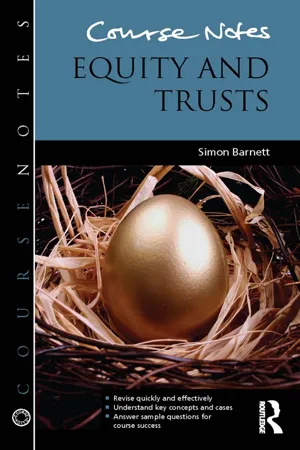
- 264 pages
- English
- ePUB (mobile friendly)
- Available on iOS & Android
Course Notes: Equity and Trusts
About this book
Course Notes is designed to help you succeed in your law examinations and assessments. Each guide supports revision of an undergraduate and conversion GDL/CPE law degree module by demonstrating good practice in creating and maintaining ideal notes. Course Notes will support you in actively and effectively learning the material by guiding you through the demands of compiling the information you need.
• Written by expert lecturers who understand your needs with examination requirements in mind
• Covers key cases, legislation and principles clearly and concisely so you can recall information confidently
• Contains easy to use diagrams, definition boxes and work points to help you understand difficult concepts
• Provides self test opportunities throughout for you to check your understanding
• Illustrates how to compile the ideal set of revision notes
• Covers the essential modules of study for undergraduate llb and conversion-to-law GDL/CPE courses.
Frequently asked questions
- Essential is ideal for learners and professionals who enjoy exploring a wide range of subjects. Access the Essential Library with 800,000+ trusted titles and best-sellers across business, personal growth, and the humanities. Includes unlimited reading time and Standard Read Aloud voice.
- Complete: Perfect for advanced learners and researchers needing full, unrestricted access. Unlock 1.4M+ books across hundreds of subjects, including academic and specialized titles. The Complete Plan also includes advanced features like Premium Read Aloud and Research Assistant.
Please note we cannot support devices running on iOS 13 and Android 7 or earlier. Learn more about using the app.
Information
Chapter 1
Equity and trusts – an overview
1.1 Equity: an introduction
1.2 Origins of equity (and trusts)
1.2.1 Historical development of equity
1.2.2 Problems with the common law
1.2.3 The development of equity
1.2.4 Problems with equity
Table of contents
- Cover
- Title Page
- Copyright Page
- Dedication
- Table of Contents
- Guide to the book
- Guide to the website
- Acknowledgements
- Preface
- Table of cases
- Table of statutes and other legislation
- 1: Equity and trusts – an overview
- 2: The trust and other concepts
- 3: The three certainties
- 4: Constitution and formalities
- 5: The beneficiary principle and non-charitable-purpose trusts
- 6: Secret trusts
- 7: Charities
- 8: Implied trusts
- 9: Fiduciary duties and conflicts of interest
- 10: Control of trustees
- 11: Duties of trustees
- 12: Powers of trustee
- 13: Variation of trusts
- 14: Breach of trust and remedies
- 15: Equitable remedies
- Index